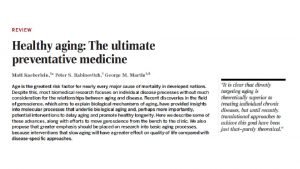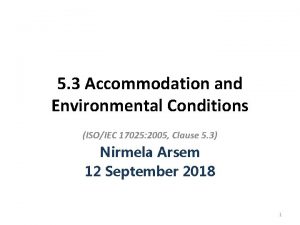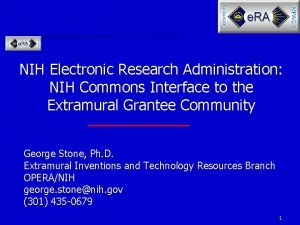Understanding Facilities and Administration Charges in NIH Grants










- Slides: 10

Understanding Facilities and Administration Charges in NIH Grants

F&A Charges – the Indirect Costs • The “total cost” of an NIH grant includes two components • Direct costs – the expense of doing the specific project (experiments) • Salary, reagents, laboratory costs, equipment • F&A charges (Facilities and Administration, AKA “Indirect costs”) – audited research costs for the institution that are hard to attribute to one specific project (How much water did that experiment use? ) • Building & equipment depreciation (for space used on NIH-funded projects), interest on bonds, research-related administrative costs (including the IRB, animal care, other compliance functions), security, waste disposal, water, power, library, computing networks and systems • Based on an average of specified costs from all NIH funded projects at an institution • Based on real, and audited, expenses incurred by the institution in doing NIH-related research


F&A Charges • There is no margin to F&A charges • In fact, institutions receive less in F&A reimbursement than they actually spend on supporting research • If an institution says they are providing money to an investigator as a incentive for applying for an NIH grant (often referred to as “returning your indirects”), the money has to come from some other institutional source, because the NIH F&A reimbursement was already allocated to real expenses and spent to support them • Those sources could include endowment income, philanthropy, state funds, or a transfer from clinical services • • Medical school tuition is already insufficient to pay the costs of education, so it cannot be a funds source. Private institutions do not generally receive state funds Most endowment income is restricted (for example, to fund a chaired professorship) New or refurbished labs are expensive and F&A provides only partial payment

How institutions invest their own funds in research This slide shows national averages on the distribution of what institutions pay to support research – the actual amounts are institution specific. On average, institutions contribute 53 cents for every dollar of sponsored research received (TDC = total direct costs). Source: “Academic Medicine – Investment in Medical Research (Technical Report)” – AAMC report 2015

Sources of School of Medicine Revenue Insert a graphic here: include clinical/hospital, Direct and F&A from sponsored programs Tuition, endowment, state, philanthropy, any other significant sources

Proposal and effect • The current administration budget proposal would limit NIH F&A expenses • This proposal would translate to a fixed F&A rate of around 12%, which would replace the current negotiated rate (typically 50 -60%) • At an institution like [your institution] this would result in a revenue loss of [$###M]! • Since building bonds and many costs associated with research will continue, and most revenue sources have already been maximized, institutions will need to aggressively trim their budgets to cope with the loss of reimbursement • Institutional funds will need to replace the federal funds, but may not be sufficient for current needs and uses

Possible effects of an F&A Cap • If the institution has diminished F&A support, most of the effect will be on personnel • Some non-tenure track faculty will likely be laid off • • • Financial exigency might also allow tenured faculty layoffs Lab staff and technicians will lose jobs Administrative support (grants offices, the IRB, animal protection, janitors) will be cut • Some buildings may be closed • Core laboratories that have been running with institutional subsidy may be closed • Institutions will prioritize efficiencies • Existing contracts, salary, and services may need to be renegotiated • The research portfolio may be reconsidered, with preference to less capital intensive research.

Proposal and effect • Institutions might limit faculty application for new awards since each research project brings with it more expenses than the institution may be able to cover (for example, more lab space) • Many institutions will fund a smaller number of faculty at a higher percentage, since there will be less money available to provide faculty salary support • Bridge funding will be limited and in some institutions unfunded faculty salaries will be reduced (or those positions terminated) • Ph. D training programs will be contracted • Post-doc positions subsidized by the schools may be terminated • Some institutions may sell their buildings to investors and lease them back, since lease expenses are a direct cost item

Faculty understanding • Some faculty have thought that indirect costs should part of their reward for obtaining a grant, but that isn’t really possible • The institutional resources that allow grant-funded research are expensive • Many of the expenses will continue regardless of changes in the F&A reimbursement rate • Although more NIH grants might be available if the proportion of funds used to pay indirect costs is reduced, in net the effect of layoffs, contraction of Ph. D training programs, loss of bridge funding, reduced salaries, loss of institutional resources and services, and cessation of new faculty hiring will make the increased number of grants less valuable than it might superficially appear
 Like charges blank and opposite charges blank
Like charges blank and opposite charges blank In keeping equipment and facilities safe and sanitary
In keeping equipment and facilities safe and sanitary Noaa nesdis org chart
Noaa nesdis org chart Lcif grant program
Lcif grant program How did land grants and new roads affect brazil?
How did land grants and new roads affect brazil? Nih institutes list
Nih institutes list Cleaning public areas facilities and equipment
Cleaning public areas facilities and equipment Food storing and issuing control
Food storing and issuing control Hotel classifications
Hotel classifications Iso 17025 facilities and environmental conditions
Iso 17025 facilities and environmental conditions Retail storage with customer pickup
Retail storage with customer pickup



















